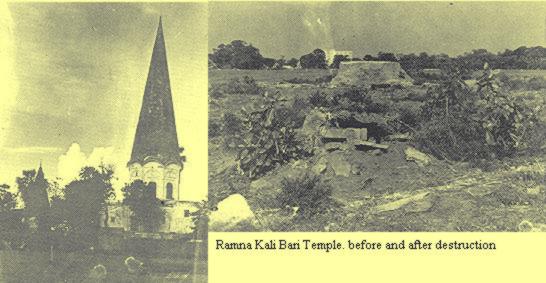Ramna Kali Bari had been one of the landmarks of Dhaka for centuries. The original monastery, called Kaatghar, is believed to have been constructed by followers of Shankaracharya who came to Dhaka some 600 years ago. Around 16th century, the Ramna Kali Bari was constructed on the site of the monastery. The temple housed the deity Bhadrakali, seated on a majestic wooden throne. Maa Anandmoyi Ashram was also to found on the same site. The Ramna Kali Bari was adorned by a tall shikhar, which could be seen from miles away. The temple had undergone renovation and development under Rani Bilashmoni’s patronage in the 19th century. A lake, excavated by either Rani Bilashmoni or the British was also present in the complex. The complex also housed the priests, their families and various devotees who would visit the sacred temple from time to time.
https://en.wikipedia.org/wiki/Ramna_Kali_Mandir
Sometime in the night of 27th March, 1971, Pakistani forces laid siege to the temple complex. The attack on the temple was an attack on Hindus and Bengali Intellectuals who had been Mujib’s stormtroopers in the Pakistani elections of 1970 that pitted East Pakistan led by Mujib against West Pakistan led by Zulfiqar Bhutto. Mujib’s Awami League swept East Pakistan but drew a naught in the Western Wing. Zulfiqar Bhutto’s Pakistan People’s party won a large number of seats in the West but had no presence in the East. With Zulfiqar unwilling to handover power to Mujib, Pakistan plunged into a political crisis. Civil war broke out and the Pakistani Army had to be called in to enforce peace. The infamous Operation Searchlight was launched by the Pakistani army to rid East Pakistan of Mujib’s supporters and eliminate all opposition. Ramna Kali Bari was one of the sites identified by Pakistani forces to its power. Late in the night, Pakistani forces began their incessant shelling of the complex, explosives were thrown around as a result of which the sacred Murtis and a part of the temple was blown away. In fear, women began wiping off the Sindur from their foreheads and began breaking the Shankhas (Conch Bangles). Devotees and residents of Ramna Bari, panic stricken, began running helter skelter, shouting ‘Pakistan Zindabad’, hoping to have their lives spared.
http://www.mayerdak.com/root/ramna.htm
By this time, Pakistani forces were securely inside the temple complex. Men and women were separated and the bloody murders began. It is believed that the temple priest was made to read out the Kalma and was then bayoneted. Similar was the fate meted out to the other men. Many others were sprayed with bullets. Dead bodies were put in a heap and set afire. By now, both Ramna Kali Bari as well as the Ma Aanandmoyee Ashram were burning. Women were raped or carried off by Pakistani soldiers.
By the break of dawn, the operation had been completed and the 6 centuries’ old Ramna Kali Bari temple had been reduced to ruins. By the end of the year, Bangladesh liberation war broke out and Pakistani forces were driven out of the country.
http://www.asiantribune.com/node/83969
As fate would have it, the government of newly independent Bangladesh, under Sheikh Mujibur Rehman turned its back to the Ramna Kali Bari Temple. Far from returning the temple to its rightful owners, Mujib handed over the land to Bangladesh’s Public works department, who, by 1972 had cleared the area of the ruins of the temple. All this while, there were talks of either rebuilding the temple or letting the ruins stay as a symbol of the horrors unleashed by demonic Pakistani forces. Mujib had the area renamed as ‘Suhrawardy Udyaan’. All traces of the magnificent Ramna Kali Bari were done away with.
During the ostensibly less secular and more Islamic regime of Ziaur Rahman, the issue of Ramna Kali Bari was put on the backburner. It was only in the year 2000 that the Awami League government under Sheikh Hasina granted Hindus the right to worship at the site of the original Ramna Kali Bari. Even so, only a temporary pandal was allowed to be constructed during Durga Puja days, which had to be mandatorily dismantled after the festivities came to an end. In 2004, permission was granted for a more semi-permanent pandal, but there were widespread allegations of harassment at the hands of the local police. In 2006, Khaleda Zia, leader of the BNP and the then Prime Minister, announced that land would be allotted for the construction of Ramna Kali Bari. However, the land to be allotted would not be where the original temple stood. More than 4 decades after Bangladeshi independence, attained at the cost of the blood of millions of its Hindu population, Ramna Kali Bari continues to be an elusive dream.
The existence of Ramna Kali Bari, a 600 old year temple has been completely done away with. The site, which was once adorned by a magnificent temple, now merely houses a derelict pandal.
